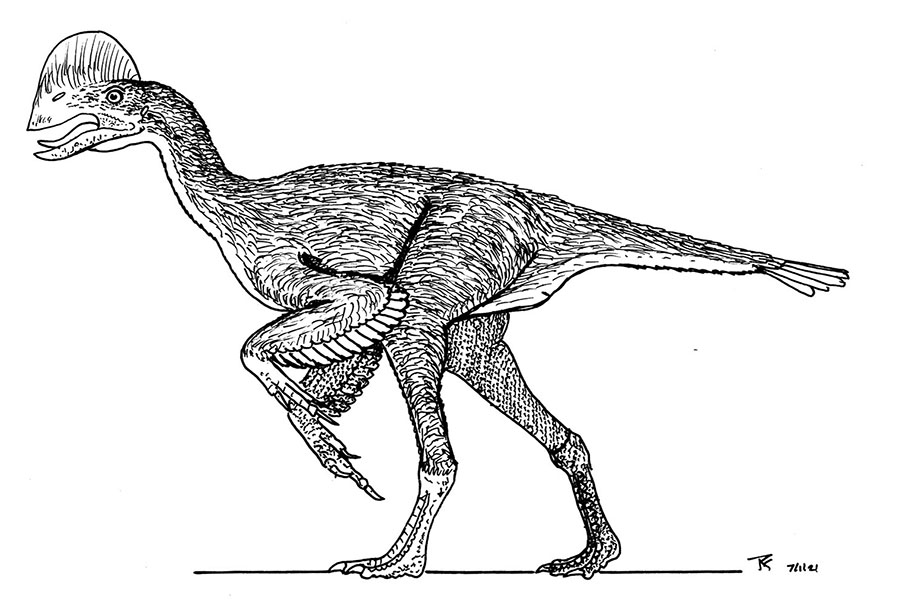
Genus: Anzu LAMANNA, SUES, SCHACHNER & LYSON, 2014
Etymology: The genus name is for Anzu, a feathered demon in ancient Mesopotamina
(Sumerian and Akkadian) mythology, and alludes to the dinstinctive appearance
of this large, presumably feathered dinosaur.
= Genus: Nova (Currie, pers. Com)
Species: wyliei LAMANNA, SUES, SCHACHNER & LYSON, 2014
Etymology: In honor of Mr. Wylie J. Tuttle, grandsont of Mr. and Mrs. Lee
B. foster, in recognition of Mr. and Mrs. Foster's generous support of the
scientific research and collections activities at Carnegie Museum of Natural
History.
= Oviraptorisauria nova TRIEBOLD & RUSSELL, 1995, TRIEBOLD, NUSS & NUSS,
2000
Holotype: CM 78000
Locality: “Sandy Quarry”, near Buffalo, Harding County, South Dakota.
Horizon: Hell Creek Formation.
Biostratigraphy:
Age: Lancian age, upper Maastrichtian Stage, uppermost Senonian subepoch, Upper Gulf Epoch, Late Cretaceous.
Material: Fragmentary skull and fragmentary skeleton; premaxilla fragments, the incomplete braincase, both quadrates and pterygoids, additional cranial fragments, the nearly complete but disarticulated mandible, multiple cervical and caudal vertebrae, numerous cervical and dorsal ribs, gastralia, and haemal arches, both scapulocoracoids, right humerus, left radius, ulna, and metacarpal II, several manual phalanges including unguals, both femora, tibiae, fibulae, astragalocalcanea, and first metatarsals, the incomplete left metatarsal V, and sevral pedal phalanges including unguals.

Anzu wyliei (modified from TRIEBOLD & RUSSELL, 1995, TRIEBOLD, NUSS & NUSS, 2000), Holotype: CM 78000.

Anzu reconstruction.
Referred material:
CM 78001: Nearly complete left and fragmetnary right premaxillae, maxillae, and jugals, the articualted braincase, quadrates, and pterygoids, the right octopterygoid, additional cranial fragmetns, all cervical and dorsal vertebrae, the incomplete sacrum, several caudal vertebrae, numerous dorsal ribs, gastralia, and hameal arches, both sternal plates, ilia, pubes, ischia, femora, tibiae, fibulae, and astragalocalcanea, the left metatarsal V, and several pedal phalanges including unguals.
FMNH PR 2296 (formerly BHM 2033): a cossified left surangular-articular-coronoid complex.
Locality: Slope County, North Dakota.
Horizon: Hell Creek Formation.
Biostratigraphy:
Age: Lancian age, upper Maastrichtian Stage, uppermost Senonian subepoch, Upper Gulf Epoch, Late Cretaceous.
Material:
MRF 319: An associted partial postcranial skeleton that includes 3 cervical vertebrae, a dorsal rib, and the left scapulocoracoid, radiusl and ulna.
Note: Some of this material indicates an animal that stood 7-8 feet at the hips.
STEIN, 2021
Locality: Tooth Draw Deposit, Butte County, South Dakota.
Horizon: Hell Creek Formation.
Biostratigraphy:
Age: Lancian age, upper Maastrichtian Stage, uppermost Senonian subepoch, Upper Gulf Epoch, Late Cretaceous.
Material:
TD-19-013: Manus ungual.
TD-16-141: Fragmentary manus ungual.
Numbers: Not given: 6 elements, a cervical, aphew phalangs and one more manus ungual.
Note: Insect bored.
= cf. Anzu wyliei TSUJIMURA, MANABE, CHIBA & TSUIHIJII, 2021
Locality: Sandy site, near Buffalo, Harding County, South Dakota.
Horizon: Hell Creek Formation.
Biostratigraphy:
Age: Lancian age, upper Maastrichtian Stage, uppermost Senonian subepoch, Upper Gulf Epoch, Late Cretaceous.
Material:
NSM PV 21055: Right metatarsal IV.
NSM PV 21086: Left matatarsal III.